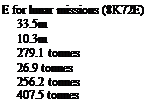AN UPPER STAGE: ENTER SEMYON KOSBERG
Spacecraft design was only one part of the jigsaw required to put the moon project together. The other crucial part was an upper stage able to send the probe toward the moon. The rocket that had launched Sputnik, Sputnik 2 and 3 – the R-7 – was capable of sending only 1,400 kg into low-Earth orbit, no further. A new upper stage would be required. Back in April 1957, Mikhail Tikhonravov had suggested that it would be possible to send small payloads to the moon, through the addition of a small upper stage to the R-7.
Chronology of the early Soviet lunar programme
4 Oct 1957 Sputnik.
28 Jan 1958 Proposal to government by Korolev and Keldysh.
10 Feb 1958 Agreement with OKB-154 (Kosberg) for upper stage.
20 Mar 1958 Approval by government of proposal for moon probe.
5 Jul 1958 Most promising works in the development of outer space.
Korolev considered two options for an upper stage. First, he turned to the main designer of rocket engines in the Soviet Union, Valentin Glushko. Glushko had designed the main engines for the R-7, the kerosene-propelled RD-107 and RD-108 (RD, or rocket engine, in Russian Raketa Digvatel). Since then, though, he had discovered UDMH, or to be more correct, it had been discovered by the State Institute for Applied Chemistry. UDMH stood for unsymmetrical dimethyl methyl hydrazine and it had many advantages. When mixed with nitric acid or one of its derivatives, this produced powerful thrust for a rocket engine. Unlike liquid oxygen – which must be cooled to very low temperatures – and kerosene, UDMH and nitric acid could be kept in rockets and their adjacent fuelling tanks at room temperature for some time and for this reason were called ‘storable’ fuels.
They were hypergolic and fired on contact with one other, saving on ignition systems. The great disadvantage was that they were toxic: men working on them had to wear full proper protective gear. The consequences of an unplanned explosion did not bear thinking about and Korolev labelled the fuel ‘the devil’s own venom’. Glushko proposed the R-7 fly his new upper stage, the RD-109.
Korolev had his doubts as to whether Glushko could get his new engine ready for him in any reasonable time. He learned that an aircraft design bureau, the OKB-154 of Semyon Kosberg in Voronezh, had done some development work on a restartable rocket engine using the tried-and-tested liquid oxygen and kerosene. Semyon Kosberg was not a spacecraft designer: his background was in the Moscow Aviation Institute, he built fighters for the Red Air Force and his interest was in aviation. Korolev, wary of Glushko’s engine and skeptical of his ability to deliver on time, persuaded Kosberg to build him a small upper stage and they signed an agreement on 10th February 1958, even before government agreement for the moon programme. The new engine, later called the RD-105 (also referred to as the RD-0105 and the RO-5), was duly delivered only six months later, in August 1958. It was the first rocket designed only to work in a vacuum. This new variant of the R-7 was given the technical designation of the 8K72E (a more powerful version of the upper stage later became the basis of the first manned spaceship, Vostok, and was known as the 8K72K).

![]()
 R-7 rocket, with upper stage block
R-7 rocket, with upper stage block
Length
Diameter (blocks ABVGD) Weight
of which frame propellant Thrust at liftoff
8K72E upper stage (block E)
Length
Diameter
Weight
Frame
Propellants
RD-105 engine
Weight
Thrust
Fuel
Pressure
Specific impulse
Burn times
![]() Burn time block A Burn times blocks BVGD Burn time block E
Burn time block A Burn times blocks BVGD Burn time block E
Source: Varfolomeyev (1995-2001)
A suborbital flight of the new moon rocket took place on 10th July 1958. The aim was to test the control system for the ignition and separation of the upper stage, but the mission never got that far, for the rocket blew up a few seconds after liftoff.










